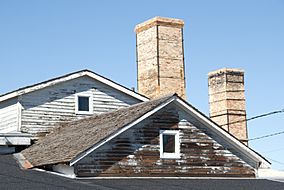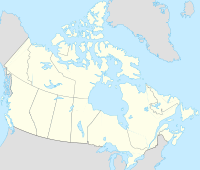Claybank Brick Plant facts for kids
Quick facts for kids Claybank Brick Plant |
|
|---|---|
 |
|
| Location | Elmsthorpe No. 100, Saskatchewan, Canada |
| Established | 1912-13 |
| Visitors | Open by appointment |
| Website | Claybank Brick |
|
Claybank Brick Plant
|
|
|---|---|
| Claybank Brick Plant National Historic Site | |
| Country | Canada |
| Province | Saskatchewan |
| Rural Municipality | Elmsthorpe |
| Founded | 1912 |
| Designated National Historic Site | 1994 |
| Designated Provincial Heritage Property | 1998 |
| Time zone | Central Standard Time |
| Postal code |
S0H 0W0
|
| Highway | Highway 339 |
The Claybank Brick Plant National Historic Site is a special place near Claybank, Saskatchewan. It sits at the bottom of the the Dirt Hills. This plant made bricks from 1914 to 1989.
Bricks from Claybank were used in famous Canadian buildings. These include the Bessborough Hotel in Saskatoon and the Chateau Frontenac in Quebec City. In 1996, the site became a National Historic Site. It shows how important industries were in the early 1900s in Canada.
Contents
History of the Brick Plant
The land around the Claybank Brick Plant has a long history. First Nations groups lived here for thousands of years. They likely used the rich clay to make pottery and tools. Later, in the late 1800s, European settlers found the valuable clay. They realized it could be used to make bricks on a large scale.
How the Claybank Plant Started
- 1886 - Clay Discovery: Thomas McWilliams was a homesteader. He found the special clay in 1886 while looking for lost cattle. He also picked Saskatoon berries that day. Thomas quickly claimed the clay-rich land in Moose Jaw. He later moved his family there. He also asked the government for permission to mine the clay. This was the first official record of the Claybank clay. For almost 20 years, Thomas mined and sold clay. He sold it to the Wellington White brick plant in Moose Jaw.
- 1904 - New Partnership: In 1904, Thomas teamed up with the Moose Jaw Fire Brick and Pottery Company. The company bought his land and other clay deposits. The clay was excellent, but it was hard to get it to customers. Moose Jaw was over 50 km away. Horses and wagons had to carry the heavy clay. This made it hard to make money.
- 1910 - Railway Arrives: Everything changed in 1910 when the Canadian Northern Railway came to the area. A special train track was built from the main line to Claybank. This solved the problem of getting products to market. Plans were made right away to build a new brick plant. It would use coal for power.
- 1912 - Plant Construction: In 1912, the Moose Jaw Fire Brick and Pottery Company bought out Thomas McWilliams. The company changed its name to Saskatchewan Clay Products. Building the new plant started in 1912 and finished in 1914. However, because of World War I, the plant had to close until 1916.
- 1916 - Re-opening and Growth: The company reorganized in 1916 and became Dominion Fire Brick and Clay Products Ltd. The plant started making bricks again right away. The company began making new products like face brick and special fire brick. These new products helped the company do well after the war. Railways and industries were growing, so there was high demand for their bricks.
- Surviving Tough Times: The special bricks also helped the company survive the Great Depression. By 1938, the Claybank plant was the busiest in Saskatchewan. During World War II, demand for their special refractory bricks was very high. These bricks were used in Corvette warships. This kept the plant busy and successful. After the war, the plant continued to grow. By 1950, it was the largest clay plant in Saskatchewan.
- 1954 - New Owners: In 1954, a company from Alberta called Redcliffe Pressed Brick bought the plant. They kept the name Dominion Fire Brick and Clay Products. The next year, A.P. Green Fire Brick Company from Mexico, Missouri took control. This company was a top producer of heat-resistant products. They updated the plant, changing six of the ten coal-fired kilns to natural gas.
- Challenges and Changes: Even with improvements, the plant faced money problems in the mid-1950s. Railways started using diesel locomotives, so there was less demand for locomotive bricks. In the 1960s, the company stopped making its famous face brick. The coal-fired kilns had given the face brick its special color. This color was lost when they switched to natural gas. By 1962, A.P. Green fully owned the plant. It continued as Dominion Fire Brick and Clay Products until 1970.
- 1971 - Decline and Closure: In 1971, the plant became part of A.P. Green Refractories (Canada) Ltd. This seemed to speed up the plant's financial problems. There was less demand for refractory bricks. Technology changed, and the plant's equipment became old. The company also downsized. All these reasons led to the plant closing in 1989 after 75 years.
- 1989 - Becoming a Heritage Site: When the plant closed in June 1989, the Government of Saskatchewan decided to protect it. A.P. Green gave the plant, its machines, and equipment to the Saskatchewan Heritage Foundation in 1992. In 1994, the plant was named a national historic site. In 1998, it officially became a Provincial Heritage Property. The Claybank Brick Plant was saved to show Saskatchewan's industrial past. Minister of Canadian Heritage Sheila Copps officially announced it as a National Historic Site on June 29, 1997. The Canadian and Provincial Governments together gave $2 million to help save and show off the plant. In 2015, the Saskatchewan Heritage Foundation worked with Prince's Charities Canada. They reviewed how the Claybank Brick Plant National Historic Site was run.
Products Made at Claybank
Face Brick: Building Beautiful Structures
The Claybank Plant made a special type of brick called Face Brick. This brick was used in many important buildings across Canada. Some examples include the Château Frontenac in Quebec City and the Delta Bessborough in Saskatoon. It was also used in the Gravelbourg Cathedral in Gravelbourg. Many courthouses and public buildings throughout Saskatchewan also used these bricks. The plant made face brick until the 1960s, when production stopped.
Fire Brick: Heat-Resistant Wonders
Claybank has rare clay deposits that are very good at resisting heat. This special clay was used to make Fire Brick starting in the 1920s. These heat-resistant bricks were used in fireplaces and furnaces. They also lined the fire boxes of CN Rail and CP Rail locomotives. During the Second World War, they lined the boilers of Corvette warships. The fire brick from Claybank was so good at insulating against extreme heat that it was even used by NASA. It helped build the rocket launch pads at Cape Canaveral, Florida.
Geology of the Claybank Area
The Dirt Hills and Special Clay
The Claybank Brick Plant is located in the Dirt Hills of southern Saskatchewan. It used clay from the nearby Massold Clay Canyons. The Dirt Hills were formed by glaciers a very long time ago. Underneath them is the Whitemud Formation. This geological formation formed in the late Cretaceous period. It is found across southern Saskatchewan and parts of Alberta. It is a source of high-quality refractory clay. This includes white kaolinitic and bentonitic clays. Claybank has two main types of clay: white and grey. They have different properties, which were useful for making different kinds of bricks.
Visiting the Claybank Brick Plant National Historic Site
What to Do at the Plant
The Claybank Brick Plant is open for tours. You can visit seven days a week from June to the end of August. Self-guided tours are available all day. Special guided tours happen daily at 10:30 AM and 1:30 PM. If you are with a school or a group, you can ask for a special tour.
The Bunkhouse Café and Gift Shop are in the interpretive center. You can find fresh, homemade food and baked goods there. They also sell Saskatchewan souvenirs and local crafts. The Claybank Brick Plant Annual Heritage Event takes place on the last Sunday of June. In June 2018, the Massold Clay Canyon 3 km Colour Run was held.
Massold Clay Canyons
Exploring the Canyons
The Massold Clay Canyons cover 256 acres. They are a historic and wildlife area right next to the Claybank Brick Plant. The canyons have old clay pits and natural wildlife areas. In 2001, the Claybank Brick Plant and Historical Society bought the land. This land has not been touched by farming. It has stayed almost the same since the last ice age. Many plants that are native to the area grow here. The hills are also home to lots of local prairie wildlife. You can go hiking in the canyons. You can get information about hiking at the interpretive center at the Claybank Brick Plant National Historic Site.
Gallery
Images from around the Claybank Brick Plant National Historic Site and the Massold Clay Canyons near Claybank, Saskatchewan.
-
View from inside a brick kiln
Nearby Attractions
The Claybank Brick Plant National Historic Site is in the RM of Elmsthorpe No.100. It is close to the communities of Claybank, Avonlea, Briercrest, and Truax, Saskatchewan. Other fun places to visit nearby include:
- Dunnet Regional Park
- Long Creek Golf Course
- Briercrest Museum
- Avonlea Heritage Museum
- First Nations ceremonial sites
- Avonlea Badlands
See also












